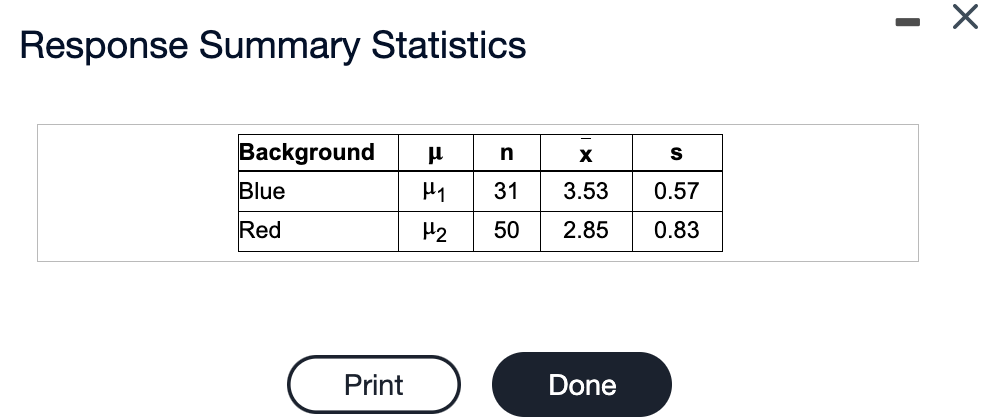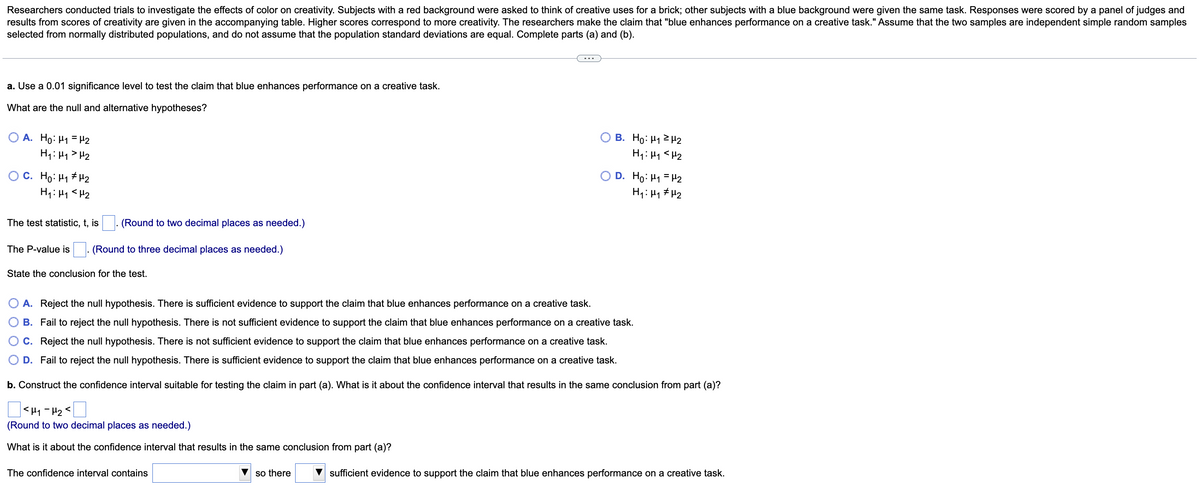Researchers conducted trials to investigate the effects of color on creativity. Subjects with a red background were asked to think of creative uses for a brick; other subjects with a blue background were given the same task. Responses were scored by a panel of judges and results from scores of creativity are given in the accompanying table. Higher scores correspond to more creativity. The researchers make the claim that "blue enhances performance on a creative task." Assume that the two samples are independent simple random samples selected from normally distributed populations, and do not assume that the population standard deviations are equal. Complete parts (a) and (b). a. Use a 0.01 significance level to test the claim that blue enhances performance on a creative task. What are the null and alternative hypotheses? O A. Ho: H1 = H2 H;: H1 > H2 O B. Ho: H1 2 H2 H: H,
Researchers conducted trials to investigate the effects of color on creativity. Subjects with a red background were asked to think of creative uses for a brick; other subjects with a blue background were given the same task. Responses were scored by a panel of judges and results from scores of creativity are given in the accompanying table. Higher scores correspond to more creativity. The researchers make the claim that "blue enhances performance on a creative task." Assume that the two samples are independent simple random samples selected from normally distributed populations, and do not assume that the population standard deviations are equal. Complete parts (a) and (b). a. Use a 0.01 significance level to test the claim that blue enhances performance on a creative task. What are the null and alternative hypotheses? O A. Ho: H1 = H2 H;: H1 > H2 O B. Ho: H1 2 H2 H: H,
Holt Mcdougal Larson Pre-algebra: Student Edition 2012
1st Edition
ISBN:9780547587776
Author:HOLT MCDOUGAL
Publisher:HOLT MCDOUGAL
Chapter11: Data Analysis And Probability
Section: Chapter Questions
Problem 8CR
Related questions
Question
4.

Transcribed Image Text:Response Summary Statistics
Background
X
Blue
31
3.53
0.57
Red
H2
50
2.85
0.83
Print
Done

Transcribed Image Text:Researchers conducted trials to investigate the effects of color on creativity. Subjects with a red background were asked to think of creative uses for a brick; other subjects with a blue background were given the same task. Responses were scored by a panel of judges and
results from scores of creativity are given in the accompanying table. Higher scores correspond to more creativity. The researchers make the claim that "blue enhances performance on a creative task." Assume that the two samples are independent simple random samples
selected from normally distributed populations, and do not assume that the population standard deviations are equal. Complete parts (a) and (b).
a. Use a 0.01 significance level to test the claim that blue enhances performance on a creative task.
What are the null and alternative hypotheses?
A. Ho: H1 = H2
B. Ho: H12 H2
H1: H1 > H2
OC. Ho: H1 # H2
H1: H1 <H2
D. Ho: H1 = H2
H4: H1 # H2
The test statistic, t, is
(Round to two decimal places as needed.)
The P-value is . (Round to three decimal places as needed.)
State the conclusion for the test.
A. Reject the null hypothesis. There is sufficient evidence to support the claim that blue enhances performance on a creative task.
B. Fail to reject the null hypothesis. There is not sufficient evidence to support the claim that blue enhances performance on a creative task.
C. Reject the null hypothesis. There is not sufficient evidence to support the claim that blue enhances performance on a creative task.
D. Fail to reject the null hypothesis. There is sufficient evidence to support the claim that blue enhances performance on a creative task.
b. Construct the confidence interval suitable for testing the claim in part (a). What is it about the confidence interval that results in the same conclusion from part (a)?
|<Hy-H2<
(Round to two decimal places as needed.)
What is it about the confidence interval that results in the same conclusion from part (a)?
The confidence interval contains
so there
V sufficient evidence to support the claim that blue enhances performance on a creative task.
Expert Solution
This question has been solved!
Explore an expertly crafted, step-by-step solution for a thorough understanding of key concepts.
This is a popular solution!
Trending now
This is a popular solution!
Step by step
Solved in 4 steps with 4 images

Recommended textbooks for you

Holt Mcdougal Larson Pre-algebra: Student Edition…
Algebra
ISBN:
9780547587776
Author:
HOLT MCDOUGAL
Publisher:
HOLT MCDOUGAL

College Algebra (MindTap Course List)
Algebra
ISBN:
9781305652231
Author:
R. David Gustafson, Jeff Hughes
Publisher:
Cengage Learning

Holt Mcdougal Larson Pre-algebra: Student Edition…
Algebra
ISBN:
9780547587776
Author:
HOLT MCDOUGAL
Publisher:
HOLT MCDOUGAL

College Algebra (MindTap Course List)
Algebra
ISBN:
9781305652231
Author:
R. David Gustafson, Jeff Hughes
Publisher:
Cengage Learning